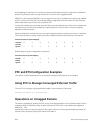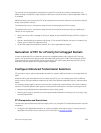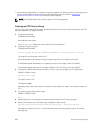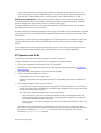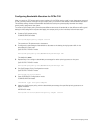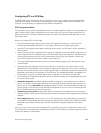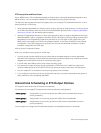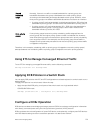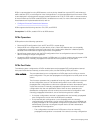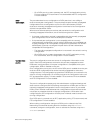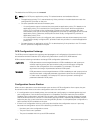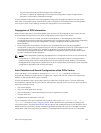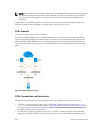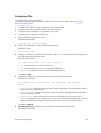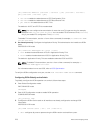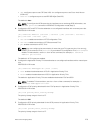
DCBx is a prerequisite for using DCB features, such as priority-based flow control (PFC) and enhanced
traffic selection (ETS), to exchange link-level configurations in a converged Ethernet environment. DCBx
is also deployed in topologies that support lossless operation for FCoE or iSCSI traffic. In these scenarios,
all network devices are DCBx-enabled (DCBx is enabled end-to-end). For more information about how
these features are implemented and used, refer to:
• Configure Enhanced Transmission Selection
DCBx supports the following versions: CIN, CEE, and IEEE2.5.
Prerequisite: For DCBx, enable LLDP on all DCB devices.
DCBx Operation
DCBx performs the following operations:
• Discovers DCB configuration (such as PFC and ETS) in a peer device.
• Detects DCB mis-configuration in a peer device; that is, when DCB features are not compatibly
configured on a peer device and the local switch. Mis-configuration detection is feature-specific
because some DCB features support asymmetric configuration.
• Reconfigures a peer device with the DCB configuration from its configuration source if the peer
device is willing to accept configuration.
• Accepts the DCB configuration from a peer if a DCBx port is in “willing” mode to accept a peer’s DCB
settings and then internally propagates the received DCB configuration to its peer ports.
DCBx Port Roles
To enable the auto-configuration of DCBx-enabled ports and propagate DCB configurations learned
from peer DCBx devices internally to other switch ports, use the following DCBx port roles.
Auto-upstream The port advertises its own configuration to DCBx peers and is willing to receive
peer configuration. The port also propagates its configuration to other ports on the
switch.
The first auto-upstream that is capable of receiving a peer configuration is elected
as the configuration source. The elected configuration source then internally
propagates the configuration to other auto-upstream and auto-downstream ports.
A port that receives an internally propagated configuration overwrites its local
configuration with the new parameter values. When an auto-upstream port
(besides the configuration source) receives and overwrites its configuration with
internally propagated information, one of the following actions is taken:
• If the peer configuration received is compatible with the internally propagated
port configuration, the link with the DCBx peer is enabled.
• If the received peer configuration is not compatible with the currently
configured port configuration, the link with the DCBx peer port is disabled and
a syslog message for an incompatible configuration is generated. The network
administrator must then reconfigure the peer device so that it advertises a
compatible DCB configuration.
– The configuration received from a DCBx peer or from an internally
propagated configuration is not stored in the switch’s running configuration.
272
Data Center Bridging (DCB)



